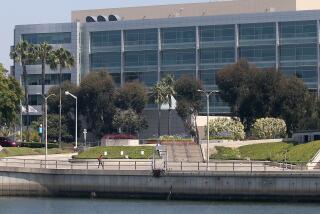Audit Finds Costly Lapses in Cal State Construction Billing : Education: Architects and contractors charged hundreds of thousands of dollars in expenses that should have been challenged, study says. An official responds that the state did not get ‘ripped off.’
- Share via
Controls over California State University’s burgeoning construction budget have been so lax that architects and contractors may have charged for hundreds of thousands of dollars in questionable overtime, travel, salaries, mistakes and late work, a scathing internal audit has found.
Fueled by enrollment pressures and expansion--including a new campus in northern San Diego County--Cal State’s construction budget increased from $191 million in 1989 to nearly $737 million last year. Yet the number of university officials supervising the projects has remained the same.
The result, according to the comprehensive audit, has been a “breakdown in the organizational structure” that has resulted in waste and questionable expenses. “This limited survey has uncovered several areas where contractors have overcharged the CSU,” the audit says.
Among the worst lapses: The failure of Cal State officials to make written demands for $800,000 in “liquidated damages,” or refunds, from contractors who missed deadlines on 20 major construction projects. Forcing companies to pay for every day they exceed a deadline is standard construction practice but auditors could not find evidence that Cal State officials followed this practice, the audit says.
The wide-ranging fiscal review--which took 4,000 hours to complete and examined selected construction projects under way from 1988 to 1992--is scheduled for discussion today by the Cal State Board of Trustees. Released in July, the report already has trustees thinking about hiring a full-time auditor to keep watch over construction at the system’s 20 campuses--work that now exceeds $800 million.
Trustee Ron Cedillos, who chairs the board’s audit committee, said the report “raises questions about the efficiency of the management of the (construction) process and it’s important that taxpayer dollars are carefully watched.”
However, the Cal State official in charge of the system’s construction oversight downplayed the report’s findings, saying that further investigation by his department turned up no major problems with how it handled architectural and construction expenses.
“In every case where they pointed out a problem, we were already in the process of fixing it or it was explained away,” said Jon Regnier, assistant vice chancellor for physical planning and development. “I can tell you without a shadow of a doubt that . . . the investigation of every instance did not uncover any area where we got, quote, ripped off.”
For instance, Regnier said the matter of liquidated damages looks worse than it is. While he acknowledged that his department did not keep written records of late charges made against contractors, the firms had valid excuses or countercharges against the university that canceled out any money Cal State should have received because of missed deadlines. These matters were handled as informal negotiations and were not easily documented, he added.
Despite the defense, university officials acknowledged in the audit that the 70-employee construction department had problems and said that they would correct them. They blamed the problems on workload, which amounted to nine projects worth $9.4 million on two or three campuses for each of the department’s construction engineers.
Cal State Auditor David E. Sundstrom acknowledged that the amount cited in the report represents only a fraction of the university’s construction budget, but he said what his staff found “certainly raised my eyebrows” and prompted the highly critical report.
Among the findings:
* Architectural firms apparently overcharged Cal State for items ranging from, in one case, car mileage to negotiated fees. During construction of the Fresno State stadium, for instance, the university paid $33,800 more than it should have because it was overly generous in renegotiating the project architect’s new fee, rather than reducing it proportionately as the project was scaled back.
Regnier said that the money involved with the Fresno stadium project came from private donations, not state funds, and that the architectural changes were required because campus officials asked that the stadium be reduced to 30,000 seats after their private fund-raising drive came up short.
The audit said that university officials were not aggressive enough in tracking and charging architects for the costly construction changes required because of architect errors in the drawings. At five buildings worth more than $69 million, architect errors added another $500,000 to the cost. The report said such overruns could be collected from an architect’s “errors and omissions” insurance policy to cover such circumstances.
* Once a project was under way, university officials often paid overtime to construction management firms without authorization for the extra work. In one construction project, Cal State officials paid nearly 40 hours of overtime--at $40 an hour--although there was no advance approval.
Auditors were also critical of construction management firms with high overhead, inflated wage rates and excessive costs for equipment rentals.
In one case, Cal State was paying an individual $50 an hour after he was put on the payroll of a construction management company, although he received $32 an hour for the same job at the same campus when he worked as a consultant for the university. In another case, auditors found that a contractor was essentially double-billing the university--charging it for two people at $40 an hour, rather than only one person as required under contract.
The report found in another instance that a firm charged Cal State $10 an hour to rent equipment that was supposedly used for 78 hours on a job; construction logs, however, show the crew was only working at the site for 62 hours.
* Cal State officials rarely, if ever, checked whether construction firms and subcontractors had adequate insurance, or whether their bonding companies were licensed by the state.
More to Read
Sign up for Essential California
The most important California stories and recommendations in your inbox every morning.
You may occasionally receive promotional content from the Los Angeles Times.










